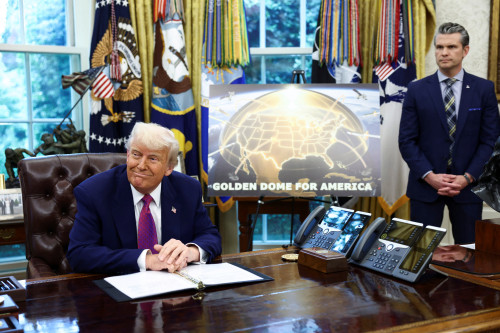By Mike Stone and Jeff Mason
WASHINGTON (Reuters) -President Donald Trump said on Tuesday he had selected a design for the $175 billion Golden Dome missile defense shield and named a Space Force general to head the ambitious program aimed at blocking threats from China and Russia.
Trump announced at a White House press conference that U.S. Space Force General Michael Guetlein would be the lead program manager for an effort widely viewed as the keystone to Trump’s military planning.
Golden Dome will “protect our homeland,” Trump said, adding that Canada had said it wanted to be part of it. The office of Prime Minister Mark Carney was not immediately available for comment.
First ordered by Trump in January, Golden Dome aims to create a network of satellites to detect, track and potentially intercept incoming missiles. The shield could deploy hundreds of satellites for missile detection and tracking.
“Ronald Reagan wanted it many years ago, but they didn’t have the technology,” Trump noted, referring to the space-based missile defense system, also referred to as “Star Wars”, proposed by Reagan.
Trump said the project would be completed by the end of his term in January 2029, but industry experts were less certain of that time frame and the cost. The program faces both political scrutiny and funding uncertainty.
“The new datapoint is the $175 billion – but the question remains, over what period of time. It’s probably 10 years,” said Tom Karako of the Center for Strategic and International Studies, adding that Silicon Valley and U.S. software expertise can be leveraged to bring advances, while also using existing missile defense systems.
The Congressional Budget Office this month estimated Golden Dome could cost as much as $831 billion over two decades.
Democratic lawmakers have voiced concern about the procurement process and the involvement of Trump ally Elon Musk’s SpaceX, which has emerged as a frontrunner alongside Palantir and Anduril to build key components of the system.
“The new autonomous space-age defense ecosystem is more about Silicon Valley than it is about ‘big metal,’” Senator Kevin Cramer of North Dakota said at the White House event. “So what’s exciting about this is it makes it available to everybody to participate – to compete.”
“Big metal” refers to legacy defense contractors.
The Golden Dome idea was inspired by Israel’s land-based Iron Dome defense shield that protects it from missiles and rockets. Trump’s Golden Dome is much more extensive and includes a massive array of surveillance satellites and a separate fleet of attacking satellites that would shoot down offensive missiles soon after lift-off.
Tuesday’s announcement kicks off the Pentagon’s effort to test and ultimately buy the missiles, systems, sensors and satellites that will make up the Golden Dome.
Trump, who said the project would be completed by the end of his term in January 2029, said Alaska will be a big part of the program and named Florida, Georgia and Indiana as also benefiting from the project.
Many of the early systems are expected to come from existing production lines. Attendees at the press conference named L3Harris Technologies, Lockheed Martin and RTX Corp as potential contractors for the massive project.
L3 has invested $150 million in building out its new facility in Fort Wayne, Indiana, where it makes the Hypersonic and Ballistic Tracking Space Sensor satellites which are part of a Pentagon effort to better detect and track hypersonic weapons with space-based sensors and could be adapted for Golden Dome.
Golden Dome’s funding remains uncertain. Republican lawmakers have proposed a $25 billion initial investment for Golden Dome as part of a broader $150 billion defense package, but this funding is tied to a contentious reconciliation bill that faces significant hurdles in Congress.
“Unless reconciliation passes, the funds for Golden Dome may not materialize,” said an industry executive following the program. “This puts the entire project timeline in jeopardy.”
(Reporting by Mike Stone and Doina Chiacu in Washington; Additional reporting by David Ljunggren in Canada; Editing by Chris Sanders and Howard Goller)





